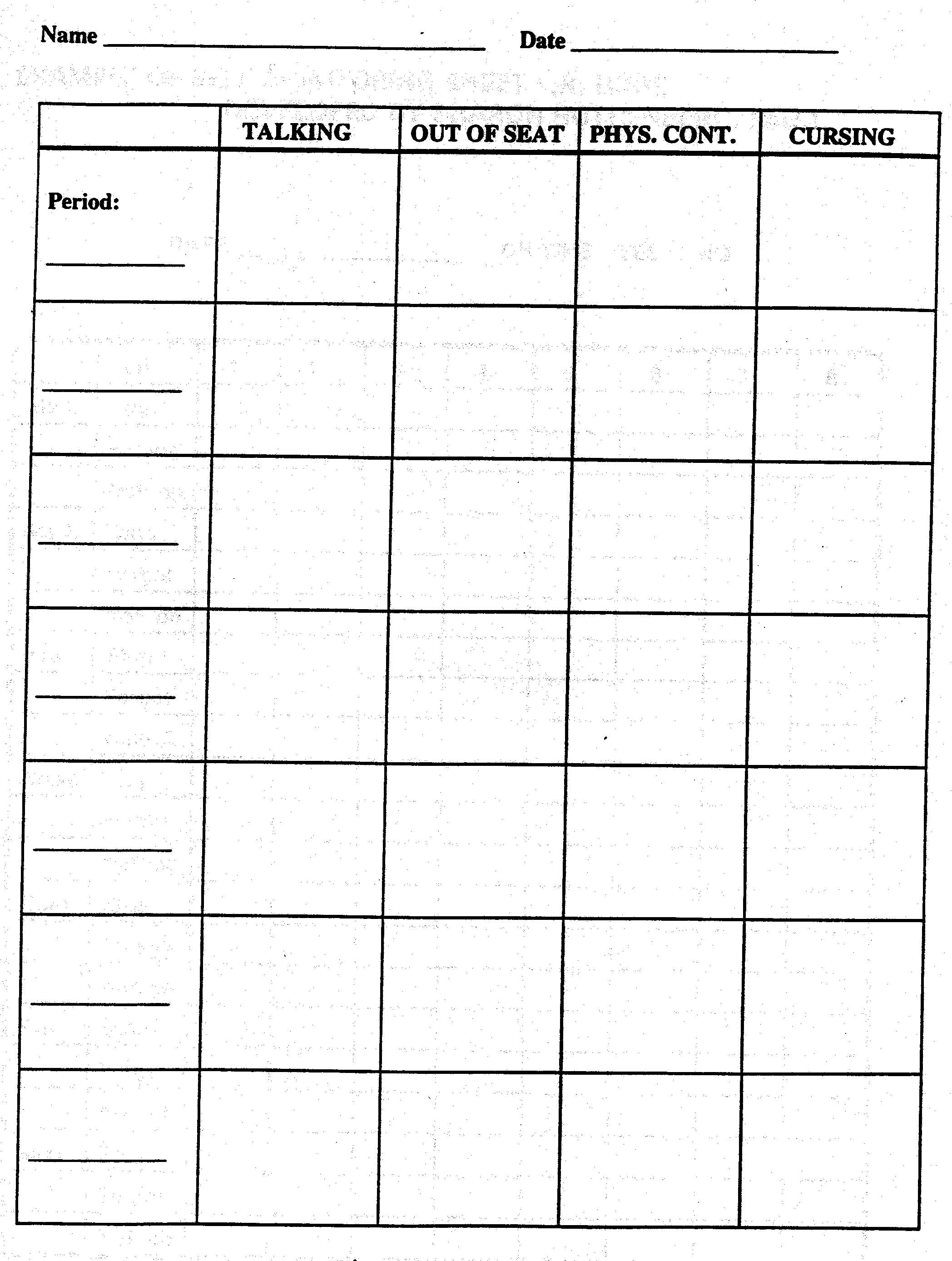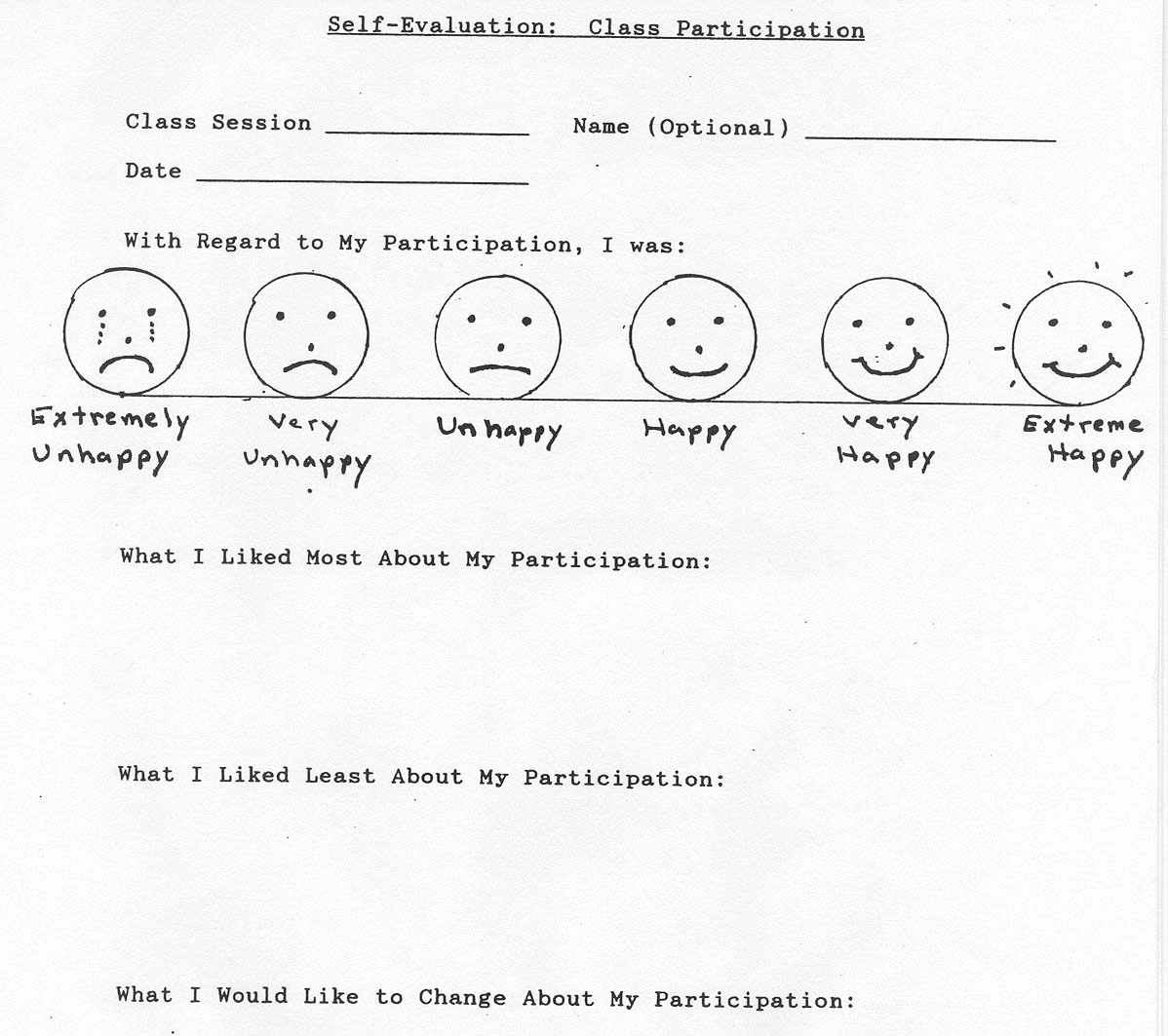
This page contains strategies for individual AND group self monitoring procedures.

You've decided that you'd like to collect data on a student's behavior (to monitor progress or evaluate performance on an IEP goal), but have too many other duties and responsibilities to spend a great deal of time observing the behaviors of particular kids and keeping a record of their occurrence. Self monitoring procedures provide a way to keep track of behavior while motivating youngsters to engage in academic and pro-social behaviors.
Self monitoring involves having students keep track of whether they are on-task, compliant, and following rules and routines. In essence, they are evaluating their own behavior. (Don't fall over sideways just yet. We'll tell you how to prevent cheating and over-rating of one's behavior) Below you'll find a couple of ways in which you can use self-recording with individual students (or a few individuals).
Self monitoring for one behavior
If you'd like for
a student to work on one (or maybe more) behavior(s),
provide him/her with a form/table in the form of a grid (see
form #1 below). Set an egg timer (the
type that allows you to turn a dial which ticks back to zero and sounds
a "ding") to any amount of time (but probably between
30 seconds and 15 minutes during the first couple of days).
When the timer sounds, the student makes one of two marks. One mark,
let's say a "plus" (+) sign, indicates that
the student was engaging in the appropriate behavior (e.g.,
on-task, keeping hands to self, being quiet) at the
exact moment that the bell sounded. Another mark, let's
say a "minus" (-) sign, indicates that the
student was NOT engaged in the appropriate
assigned behavior when the bell sounded.
In this version, it does not matter what the student was doing before or after the bell, only what was happening at the exact moment of the bell sounding (so be sure the student can't see the timer and anticipate the bell). If the student misbehaved a lot during the time period, that does not matter (in this version)...only the behavior happening during the precise moment of the bell's sound matters. Reset the timer to any amount of time and return to your duties until the next "ding" when you'll have to reset the clock again (or have a trustworthy student do it for you) as the target student again self-evaluates. At the end of the period/day, if the student meets a predetermined percentage of times engaged in the behavior, s/he receives a prize (e.g., sticker, star, point, pencil, computer time). You may want to have predetermined rewards for different levels of performance, with better performance earning a better prize. Keep the ratings sheets for your records. Perhaps graph the student's performance so that s/he can visually see his/her progress.
As the youngster improves in performance, you may decide to move to a variation of this system in which when the bell sounds, the student rates him/herself on a 0-4 scale. A zero rating means that the student did not show the desired behavior at all during the time between bells. A "1" rating indicates that the behavior was shown at least once (or a very short time) between the sounding of the bells. A "2" rating indicates that the behavior was displayed for more than a short time, but less than half of the time period. A "3" means that the behavior was shown at least half the time. A "4" score indicates that the student believes s/he was engaging in the desired actions for almost all the time. A "5" indicates "perfect" performance during the time between bells.
If you are working with the student on complying
with your directions, another variation is to figure the % of directions
with which the student complied. Each direction is followed by a
student response and then a student self-recorded marking of "yes"
or "no" in a space on the table/grid
for that direction. An empty space counts as a "no"
(the
student was probably engaged in defiant behavior at the moment).
This version might not work well with defiant/non-compliant youngsters.
What might work better is an "after the fact" self-scoring in which, at
the end of the period, the student rates his/her compliance with your directions
on a 0-5 scale. "Zero" means
that no directions uttered by you were met with his/her compliance during
the period. A "1" rating indicates
that s/he complied with at least one direction. A "2"
rating indicates compliance with most directions after a period of time
or with reminders/repeating of directions. A "3"
is recorded for general compliance with nearly all directions, and a "4"
is recorded for compliance with all directions (with some hesitation or
resistance). A "5" indicates
quick and complete compliance with all directions. Another scoring
procedure would awarded 3 points for
independent and voluntary compliance with all rules, a "2"
for complying with reminders to follow the rules, and a "1"
for complying with directions sometime during the period (however
shortly). You might devise your own
scoring system to meet the abilities of your particular students
to meet expectations.
How do I prevent cheating
by students when they self-evaluate?
Yes, students might be tempted to rate their behavior
more positively in order to obtain the reward with less effort. One
way to prevent this occurrence is by secretly monitoring that student on
a periodic basis. The student is made aware that you might be doing
so on any given day. On days when you do observe the youngster's
performance, meet with him/her at the end of the class/day. Compare
your records. For each time period/bell sounding in which your scores
agree, make a note of that concurrence. If agreement is 100%, give
prizes/points that are better than the prizes for 90% agreement, which
are better than the prizes/points for 80% agreement. Less than 80%
concurrence will probably require retraining or more frequent monitoring
by you. You might even build in a penalty of some sort for very low
agreement rates, but do remember that the idea is to inspire kids to try
harder...focusing on the negative can create defiance and result in the
student deciding to discontinue attempts to improve his/her behavior. Stay
positive!!
Responsible & Motivated
Kid?
If you have a trustworthy and highly motivated student, you might allow
him/her to set goals and ascertain whether they were met. You might
even let him/her "self-reinforce", deciding if he or she is deserving of
a prize or priviledge to which s/he has access and is able to give to him/herself.
Forms for use by students
1. "Grid" type of self-recording form

2. Multiple behavior, multiple period self-recording form

3. Self-recording form (uses faces instead of points for younger students)

Steps to Follow
1. Devise forms and obtain materials (e.g.,
bells, prizes)
2. Explain the program (go over
the materials and procedures)
3. Conduct a practice session to be sure everything
is understood
4. Start the program
Group Self-Monitoring Procedures
Translation of terms used in the article below:
Subject
= student
Operant response = required
student action when given a signal or cue
Extinction = when a behavior
"dies out" due to lack of reinforcement/rewards for showing it
What is Whole Class Self-Monitoring?
Author: Fred
Roemer (Previously
published at: http://www.pb5th.com/selfmoni.shtml)
Fred
is a 5th grade teacher (and trouble maker) in Tampa,
Florida.
Whole class self-monitoring
is an adaptation of individual self-monitoring techniques developed to
increase self-control in at-risk students. At its simplest, self-monitoring
involves a subject keeping a frequency tally of his or her own targeted
behavior. The technique was originally used as a
data-gathering or assessment method, especially useful for times when a
clinician could not be present to observe the behavior of the client.
The clinicians taught their clients to observe and record
their own behavior. It soon became apparent, however, that the
very act of systematically observing one's one behavior had reactive effects
- it changed the observed behavior for the better.
Whole class self-monitoring takes advantage of this
reactive effect with the entire population of a classroom. Instead of targeting
a few at-risk students, the whole class participates.
Whole class self-monitoring employs most of the methods developed
for individual self-monitoring - frequent, evenly spaced behavior checks![]() ;
an operant response to a signal; and an emphasis on honest self-reporting.
;
an operant response to a signal; and an emphasis on honest self-reporting.
Why Whole Class Self-Monitoring?
It helps prevent the problem of targeted at-risk students (who are ideal candidates for self-monitoring techniques) perceiving themselves as different. Even "model" students benefit from learning self-control and constructive introspection.
Students more adept at the language and conventions of introspection serve as positive role models for at-risk students. The language of self-monitoring and introspection can be taught, modeled, and used in everyday whole class situations.
The bonding in the classroom that results from the
discussions and modeled behavior benefits all students, and it especially
benefits at-risk students. The classroom structure that develops
from the self-monitoring routine benefits all students, especially at-risk
students.
A Model for a Whole Class Self-Monitoring System:
Any self-monitoring system - whether individual or entire population - should include:
-Regular, evenly spaced
"behavior checks" during which the students focus on their behavior.
-An individual tracking sheet for recording behavior
observations. I call these sheets conduct
cards. Click to see a picture of
a conduct card
-An audible or visual cue to signify the behavior
check.
-An operant response to the cue - for example, the
cue, a bell, rings and the students hold up
their conduct sheets.
-A plan for withdrawal from the system.
In addition, whole class self-monitoring should include
a short discussion period in which students have an opportunity to focus
on and discuss in objective terms the behavior of themselves and their
classmates. The discussion - especially as you are introducing the system
the to a class - should concentrate on honest self-reporting and not be
overly judgmental of behavior, both positive and negative.
Self-Monitoring System in an Elementary Classroom:
I have used self-monitoring in first, third, fourth, and fifth grade classes. We could probably adapt it to any grade. (personal notation material deleted here)
Adjust class schedule: This is perhaps
the most intrusive aspect of whole class self-monitoring and the most important.
Structure is beneficial, especially for at-risk students. The students
should
know what activities occur preceding each behavior check and a tight
class structure accommodates this. Later, as the students become familiar
with the system, you can relax classroom structure. Figure out the length
of time between behavior checks and adjust your class schedule as much
as possible so that behavior checks occur during transition periods. I
begin with 30 minute intervals between checks.
Decide on Cue:
A timer with an audible ring is ideal. I use
an alarm on a computer set at 30 minute intervals. It plays a sound
clip from the movie, "The Wizard of Oz."

A kitchen timer also works well, and you can set it manually if your routine changes during the day.
Design the Tracking Sheet:
The tracking sheet should reflect the class schedule
and should be easy for the students to use. I use picture clues for each
time slot (see the sample)
and a choice of a happy![]() ,
straight or sad side to describe behavior. I do not require that my students
have their sheets signed. On the tracking sheet I use there is a slot for
my opinion of each child's total behavior for the day so that students
can compare their self-reporting with my judgment.
,
straight or sad side to describe behavior. I do not require that my students
have their sheets signed. On the tracking sheet I use there is a slot for
my opinion of each child's total behavior for the day so that students
can compare their self-reporting with my judgment.
Choose Operant Response:
The students in my class raise their conduct card
over their heads when they hear the cue.
Begin the Program:
(See Language
of Self Monitoring) The first behavior
check can be the first activity of the morning. Continue with behavior
checks throughout the day. The language and thinking of self-monitoring
and reporting will most likely need to be modeled heavily at first.
Parents should be notified.
Plan for Extinction: Whole class
self-monitoring should not become a permanent conduct system. Once the
students become used to honestly examining their behavior, the system becomes
unnecessary. Either plan for using self monitoring for a set
length of time, or plan for gradually exempt appropriate students from
conduct sheet and behavior sheets until the whole class no longer
needs them. What will most likely happen is that the students
in your class who most need a self-monitoring system (the
at-risk kids) will continue to use the self-monitoring system
long after
the rest of the class has dropped it.
Language of Self-Monitoring
Many students are unfamiliar with the language and
concepts of self monitoring and introspection. Teaching and modeling of
the language is a very important component of the whole class
self-monitoring system. The teaching emphasis should be on talking
accurately and specifically about one's own behavior and talking appropriately
and specifically about the behavior of others. The focus is on honesty
and becoming responsible for one's own behavior.
Praise accurate self-reporting, not behavior, during behavior checks.
"Were you honest about your behavior?" When a student accurately and specifically reports and marks his or her behavior, I talk about the need for the students to become responsible for their own behavior - I don't want to be your baby sitter. I want to be your teacher. When students show some responsibility, I compliment them for growing up. When praising for appropriate behavior, I often reward a students specific statement about their behavior with "Ray is showing responsibility for his behavior." or "Kendra is monitoring her own behavior."
I introduce the concept of conscience and the ability
to heed it as "hearing your little voice" and "being able to listen to
your little voice."  I give examples of the little voice, such as when a student is alone in
the kitchen with a full cookie jar with an opportunity to eat some cookies
without getting caught: You know you won't get caught. But still,
there is a voice inside your head telling you it's wrong to take a cookie.
You know you're growing up when you begin to hear the little voice.
You know you're being responsible when you begin to listen to the little
voice. Many children can relate little voice and conscience to Jiminy
Cricket
I give examples of the little voice, such as when a student is alone in
the kitchen with a full cookie jar with an opportunity to eat some cookies
without getting caught: You know you won't get caught. But still,
there is a voice inside your head telling you it's wrong to take a cookie.
You know you're growing up when you begin to hear the little voice.
You know you're being responsible when you begin to listen to the little
voice. Many children can relate little voice and conscience to Jiminy
Cricket , who was the
little voice for Pinocchio
, who was the
little voice for Pinocchio  in
the Walt Disney film version.
in
the Walt Disney film version.
Hints and Tips
Avoid any other conduct systems while you're using whole class self-monitoring. The emphasis is on internal, not external, control.
Avoid wholesale stickers and treats when using the self-monitoring system. Intrinsic rewards are what you're after. Praise is the big reward in my class; except for special occasions, the only extrinsic positive consequence is an increase in free time.
Rules and consequences should be maintained. Many students can award themselves appropriate consequences on their own once they become used to and adept at self-monitoring.
Praise honest self-reporting. At first, de-emphasizing judgment about reported behavior is important, so that the students are not afraid to be honest about their behavior. If a child reports that she or he ran in the halls on a trip to the bathroom, you might say, "Good for you, Nicole, you were honest about your behavior. What should you have been doing?" Even severe behavior gets praise if reported honestly without prompting, "Way to go, Chris, you were honest about your behavior. Now please go to time out." (I use a silent signal for time out; the students set their own time. I instruct students that time out is thinking time and that they may return to the class when they feel able to monitor their own behavior again.)
Never change the mark a student has given him/herself. Prompt, instead, for honesty. An important part of whole class self-monitoring in my classroom is input from other students. I might ask another student to give opinion about the behavior of another student, or into the honesty of the student's report.
Teach appropriate group interaction.
Teach students how to give honest, appropriate and polite opinions about
each others' self-reports. Teach how to give specific compliments
for honesty
and appropriate behavior.
Gradually let the students take over.
At first, I had to mediate all behavior check discussions. Now the students
discuss each other's behavior and honesty among their table groups at each
check. I circulate to give praise for any honest reports and
for specific, appropriate criticism and compliments.
Tattle only at behavior checks. (Unless, of course, a student physically harms or threatens.) Before a student can tattle on another student, she or he must give two compliments about that student.
Teacher-talk should be at least 3:1 positive
to negative throughout the day. This sets the tone for
positive talk at behavior checks, and really helps keep the students thinking
positively about their behavior. Positive statements should be as
specific as possible. Negative statements should be as nonjudgmental
and free from emotion as possible. How do you know if you are maintaining
a 3:1 ratio? Have someone keep a tally of your statements for
a half-hour or so. Some teachers wear
a counter on their risk to keep track of their statements. A
3:1 ratio may sound easy, but it really takes some practice for most of
us to achieve that ratio. Try going an hour with no negative
statements. In addition, the 3:1 ratio should apply to every
student in your class. Maintaining 3:1 positive with little Amber
is easy, but you may have to work on your statements toward Shawn.
Gradually increase the time between behavior checks. This is part of extinction. I usually increase the interval from a half hour to an hour after a few months. At the hourly behavior checks, the students discuss and give themselves marks for behavior in the two preceding time slots. When I first increase the time, we spend a week having a short "behavior thinking time" at the cue to the half-hour slots when the card is not used.
Do not increase the time between cues.
I keep my timer cue going off at half-hour intervals even when nobody in
the class is using a conduct sheet. It often triggers the operant response
and
signals the class to monitor their behavior.
Make a big deal of extinction.
I call it "graduation" from the conduct card and give out a special certificate
when a student has graduated. With primary grades I have also arranged
to have
graduations announced to the whole school during the morning announcements.
My class knows the criteria for graduation - it is specific and we review
it regularly.
Apply self-monitoring to work habits and learning.
Becoming responsible for one's own learning and work is a big part of the
criteria for graduation from the conduct sheet in my classroom.
Let parents know what is going on. I have had a very positive
response from parents about whole class self-monitoring. In a recent
parent survey, many of my responding parents mentioned
in the comments section that their children were more aware of and
honest about their behavior. One parent in my classroom even used
a modified version of the system at home.
Give it time. Inappropriate behavior may increase substantially when the system is initiated. Testing its limits is natural for the students. Be consistent, keep praising honesty and in two or three weeks, you should be seeing some pleasant results.
It works. Frequent behavior
checks seem like a big interruption to the instructional day, and at first
they are. However, I found that I had a noticeable increase in teaching
time once the system
became established. On-task time increased greatly, especially
among targeted students. Classroom Interruptions, especially for
tattling, decreased.
Students need time to adapt to a whole class self-monitoring
system and so does a teacher. It takes a good deal of energy and "with-it-ness"
to adapt to the behavior checks and to ease initial class discussions.
Nevertheless, in my experience, the rewards you receive later - a relaxed,
functioning classroom and mature, responsible students - make the extra
effort. It's more than worth it.
Thanks Fred!
This piece was originally published on Fred Roemer's
own web site. You can find out more about Fred and his 5th grade
class at http://www.pb5th.com/
| Click here for an example of how one teacher implemented self monitoring with his students |
| Click here for another example of self monitoring with a student with ADHD who curses. |

![]()
Hey Pooch...you're not a polar bear! (To
make sense of this statement, check out Fred's site)
| Fetch Dr. Mac's Home Page |
Author: Tom McIntyre
www.behavioradvisor.com